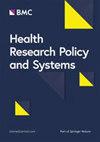Use of qualitative research in World Health Organisation guidelines: a document analysis
IF 3.6
2区 医学
Q1 HEALTH POLICY & SERVICES
引用次数: 0
Abstract
Guidelines depend on effect estimates, usually derived from randomised controlled trials, to inform their decisions. Qualitative research evidence may improve decisions made but where in the process and the methods to do this have not been so clearly established. We sought to describe and appraise how qualitative research has been used to inform World Heath Organization guidance since 2020. We conducted a document analysis of WHO guidelines from 2020 to 2022. We purposely sampled guidelines on the topics of maternal and newborn health (MANH) and infectious diseases, as most of the qualitative synthesis to date has been conducted on these topics, likely representing the ‘best case’ scenario. We searched the in-built repository feature of the WHO website and used standardised search terms to identify qualitative reporting. Using deductive frameworks, we described how qualitative evidence was used to inform guidelines and appraised the standards of this use. Of the 29 guidelines, over half used qualitative research to help guide decisions (18/29). A total of 8 of these used qualitative research to inform the guideline scope, all 18 to inform recommendations, and 1 to inform implementation considerations. All guidelines drew on qualitative evidence syntheses (QES), and five further supplemented this with primary qualitative research. Qualitative findings reported in guidelines were typically descriptive, identifying people’s perception of the benefits and harms of interventions or logistical barriers and facilitators to programme success. No guideline provided transparent reporting of how qualitative research was interpreted and weighed used alongside other evidence when informing decisions, and only one guideline reported the inclusion of qualitative methods experts on the panel. Only a few guidelines contextualised their recommendations by indicating which populations and settings qualitative findings could be applied. Qualitative research frequently informed WHO guideline decisions particularly in the field of MANH. However, the process often lacked transparency. We identified unmet potential in informing implementation considerations and contextualisation of the recommendations. Use in these areas needs further methods development.世界卫生组织指南中定性研究的使用:文件分析
指南的决策依赖于效果评估,效果评估通常来自随机对照试验。定性研究证据可能会改进决策,但在这一过程中,定性研究的位置和方法尚未明确确立。我们试图描述和评估自 2020 年以来,定性研究如何被用于为世界卫生组织指南提供信息。我们对 2020 年至 2022 年的世界卫生组织指南进行了文件分析。我们特意抽取了关于孕产妇和新生儿健康(MANH)以及传染病主题的指南样本,因为迄今为止大多数定性综合研究都是针对这些主题进行的,很可能代表了 "最佳 "情况。我们搜索了世界卫生组织网站的内置资料库功能,并使用标准化的搜索条件来确定定性报告。利用演绎框架,我们描述了如何利用定性证据为指南提供信息,并评估了这种使用的标准。在 29 份指南中,一半以上使用定性研究来帮助指导决策(18/29)。其中,共有 8 份指南利用定性研究为指南范围提供依据,所有 18 份指南均利用定性研究为建议提供依据,1 份指南利用定性研究为实施方面的考虑提供依据。所有指南都借鉴了定性证据综述 (QES),其中 5 份指南进一步补充了主要定性研究。指南中报告的定性研究结果通常是描述性的,确定人们对干预措施的益处和害处的看法,或对计划成功的后勤障碍和促进因素的看法。没有一份指南对如何解释定性研究以及在为决策提供信息时如何与其他证据一起权衡进行了透明的报告,只有一份指南报告在专家小组中加入了定性方法专家。只有少数指南通过说明定性研究结果可应用于哪些人群和环境,来说明其建议的背景。定性研究经常为世卫组织的指导方针决策提供信息,尤其是在男男性健康领域。然而,这一过程往往缺乏透明度。我们发现,在为实施考虑因素和建议背景提供信息方面,定性研究的潜力尚未得到发挥。在这些领域的应用需要进一步的方法开发。
本文章由计算机程序翻译,如有差异,请以英文原文为准。
求助全文
约1分钟内获得全文
求助全文
来源期刊

Health Research Policy and Systems
HEALTH POLICY & SERVICES-
CiteScore
7.50
自引率
7.50%
发文量
124
审稿时长
27 weeks
期刊介绍:
Health Research Policy and Systems is an Open Access, peer-reviewed, online journal that aims to provide a platform for the global research community to share their views, findings, insights and successes. Health Research Policy and Systems considers manuscripts that investigate the role of evidence-based health policy and health research systems in ensuring the efficient utilization and application of knowledge to improve health and health equity, especially in developing countries. Research is the foundation for improvements in public health. The problem is that people involved in different areas of research, together with managers and administrators in charge of research entities, do not communicate sufficiently with each other.
 求助内容:
求助内容: 应助结果提醒方式:
应助结果提醒方式:


